Explaining the main drivers of anti-immigration attitudes in Europe
30 November 2020 /
EU- Logos 11 min
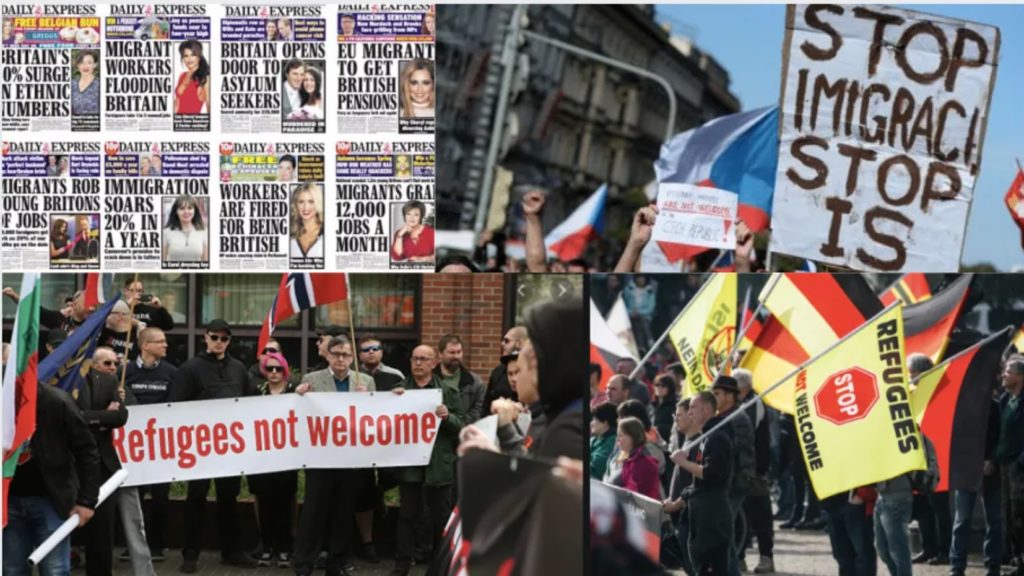
In the midst of the European Commission’s New Pact on Migration and Asylum debate advocated by the European Commission [COM(2020) 609, 23.9.2020], it is interesting to assess the public opinion about immigrants, and immigration, in Europe.
According to the 2017 Special Eurobarometer 469 “Integration of immigrants in the European Union” (Figure 1), “38% of Europeans think that immigration from outside the EU is more of a problem than an opportunity”[1]. This number varies across European countries. It is not a surprise that Hungary, which is known for its anti-immigration stance, is the country where the percentage is the highest (63%), whereas Sweden, known for its overall pro-immigration attitude, counts 19%, one of the lowest percentages.
Figure 1
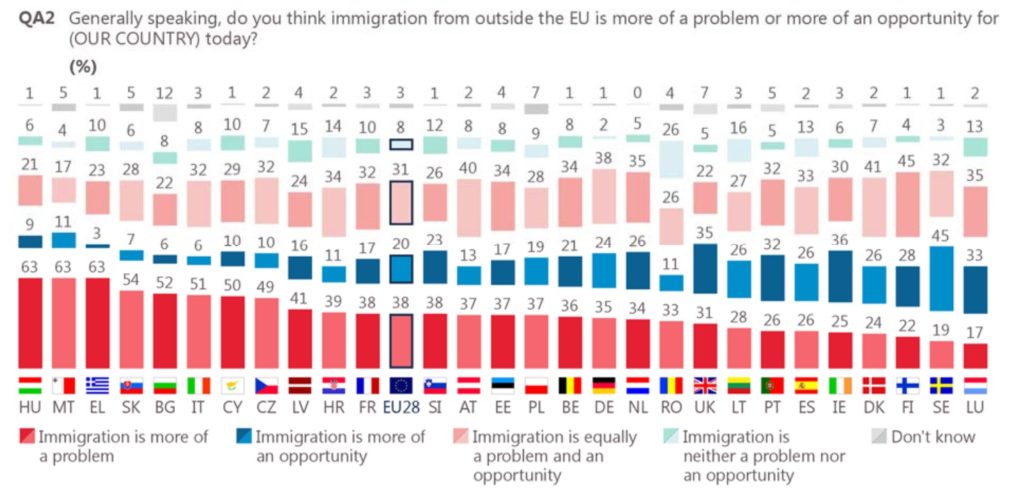
Therefore, in some European countries, the negative perception of migrants is still prevalent. Rather than assessing the fluctuation of the anti-immigrant sentiment in Europe, this article will try to explain the main drivers of anti-immigrant attitudes, linking several theories on the subject with facts. In this article, we will talk about the anti-immigrant feeling towards immigrants from non-European countries, especially Middle Eastern and African countries, since they were the main countries of origin during the 2015/16 migrant’s crisis. This article’s aim is not to criticize the anti-immigrant sentiment, but rather trying to understand what leads to the development of these attitudes.
A threat-driven fear of immigration
The main driver of anti-immigrant attitudes is the perception of a threat, fueling fears that immigrants will have a negative impact on one’s way of life. This fear is explained by sociologists through the “group-threat theory”[2]. In this theory, when an out-group enters a country (in this case, migrants), the in-group (the hosting country’s citizens) tends to perceive them as a threat to their resources, because they will compete for them. This perception is generated by the anticipation of negative outcomes related to the migrants’ arrival, and fuels anti-immigrant attitudes[3]. The competition can occur over “tangible (e.g., housing or labor market issues) as well as intangible goods (e.g., religious or language issues)”[4]. Therefore, most of the academic studies explaining opposition to immigration and immigrants retain two main threats: the realistic threat, which has an economic and security dimension, and the symbolic threat[5], which is about national identity, values and clash of cultures.
The realistic threat
The realistic threat applied to anti-immigrant sentiment relies on the assumption that host countries’ citizens will perceive immigrants as an economic threat and financial burden, but also as a physical security threat.
A perceived economic threat and financial burden
The Dublin regulation, implemented by the EU to avoid “asylum shopping”, is a striking example of the perceived economic and fiscal threat of migrants. Indeed, behind one aspect of this term, there is the perception that migrants are going to cheat the asylum system to choose the country with the best social benefits. Thus, it shows that native workers fear that a massive arrival of migrants will threaten their jobs and wages, but above all, these migrants would become a financial burden by taking advantage of the benefits[6].
As Figure 2[7] shows, if the financial burden concern seems confirmed, the economic one is more ambiguous. Indeed, more European citizens tend to agree rather than disagree to the statement that immigrants are a burden to the welfare system (total agree : 56%, total disagree: 38%). However, more people tend to disagree to the assumption that immigrants “take jobs away from workers” (total disagree: 57%, total agree: 39%).
Figure 2
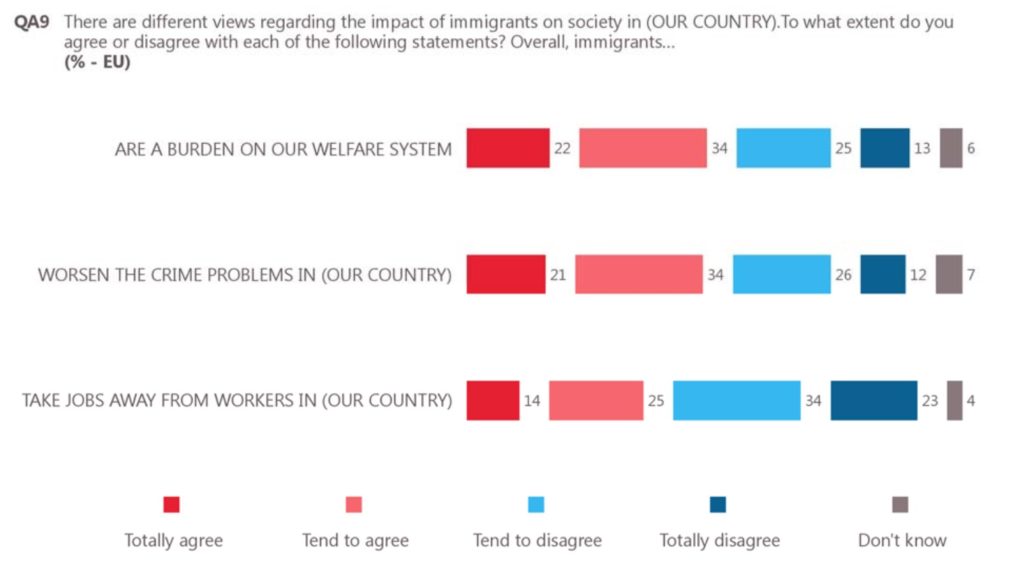
Therefore, it seems that the fiscal threat weights more than the economic one when analyzing anti-immigrant attitudes.
The physical security concerns
The other aspect of the realistic threat is the security one. This security dimension is significant when speaking about contemporary anti-immigrant attitudes. Indeed, the specter of ISIS has considerably increased fears of migrants coming from Middle Eastern countries. Indeed, one of the problems intrinsic to the migrant crisis was the poor management of European borders, which did not allow an efficient identification of migrants. This mismanagement gave the impression that terrorists could easily enter Europe through migration routes. After the November 2015 Paris terrorist attacks, these security concerns grew significantly, since one of the perpetrators of the attacks allegedly entered Europe as a refugee. And rapidly, some people mixed up immigration with the terrorist attacks[8]. However, Legewie’s research on the subject revealed that the effect of terrorist attacks is profound in the short term but tends to decrease in the long term[9].
Along with terrorist concerns, immigration is often seen as worsening crime levels in a country. As Figure 2 (above) highlights, there are more than half of European citizens that agree with the statement that immigrants “worsen crime problems” in a country (55%). Again, this fear is boosted when a crime involving migrants happens. For example, the events in Germany of New Year’s Eve 2015 (December 31, 2015), when immigrant men were accused and condemned for assaulting women, fueled negative attitudes towards immigrants among Germans[10].
As a matter of fact, when people need to choose between their own physical security or human rights concerns, for some security will prevail[11]. It is the same when dealing with economic or financial issues. And this is why, the only consensus that exists for the New Pact on Migration and Asylum is about the securitization of the frontier and pushing back migrants.
The symbolic threat
A perceived threat to national identity, culture and values
The anti-immigrant attitudes are not only motivated by economic or security concerns, but also by more intangible ones, such as national identity, culture and values. This perceived threat led, in the US but also in Europe, to the development of “nativism”. The latter is “a philosophical position, sometimes translated into a movement, whose primary goal is to restrict immigration in order to maintain some deemed essential characteristics of a given political unit”[12]. Nativists are often related to right-wing parties. Actually, they are also found in leftist parties. This nativism is indeed not about left/right division but more as a us/them division[13]. This concept existed before the migrant crisis but was increasingly put in the spotlight after the 2015/16 crisis, due to the rhetoric of some parties in a context of fear for the national identity.
Several examples of this “symbolic threat” related to immigration can be found across Europe. For instance, in France, a 2017 survey found that 72% of the French people think that immigration threatens their way of life[14]. More surprisingly, it also showed that 48% of French people believe in the “grand remplacement” theory[15]. This conspiracy-theory, developed by Renaud Camus in his 2011 book “Le grand remplacement”[16], claims that immigration is “a political project of replacement of one civilization by another deliberately organized by our political, intellectual and media elites”[17]. These figures, therefore, show that the symbolic threat holds an important place in representations of immigration in France.
A symbolic threat often related to racial prejudice
The “symbolic threat” can also be related to a racial prejudice[18]. Intra-European immigration tends to be more accepted than non-European/non-white immigration[19]. When it comes to the Muslim community, the racial prejudice tends to be stronger. According to a 2016 Pew Research Center’s publication, views of Muslims are more negative in Eastern and Southern Europe. For example, in Hungary, 72% of the people interviewed have a negative view of Muslims (Figure 3)[20]. As we stated before, Hungary is one of the European countries where the anti-immigrant sentiment is the strongest. Therefore, we can assume that racial prejudice against Muslims is related to negative attitudes towards immigrants. The other way around, in Sweden, less people have negative views of Muslims, and less people have negative attitudes against migrants.
Figure 3
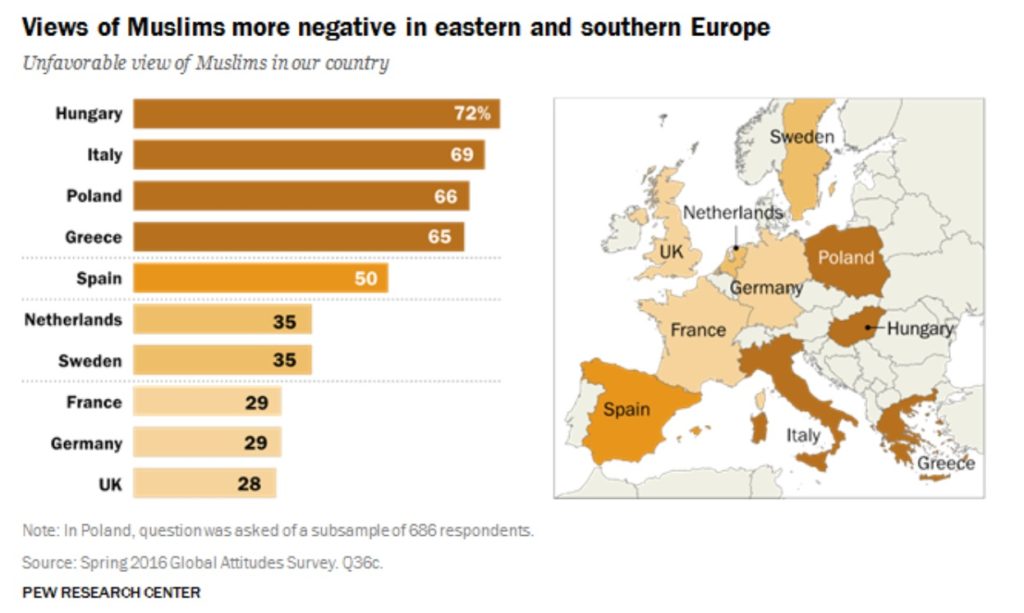
Group-threat versus intergroup contact : What is the importance of the size of the immigrant group?
According to the “group-threat theory”, anti-immigrant sentiment becomes stronger when the out-group (the immigrants) threatens to overrun the in-group (nationals of the host country)[22]. Consequently, did the large inflow of asylum seekers in 2015/16 to Europe led to a rise in anti-immigrant attitudes?
According to the group threat theory, we would say yes. However, the answer is more nuanced across European countries. As we can see in Figure 4[23], in some Eastern European countries that were directly impacted by the crisis, such as Hungary at its beginning, rejection increased and perception of migrants became more negative. In some other European countries, it is the opposite (mainly Western European countries). How can we explain that?
Figure 4
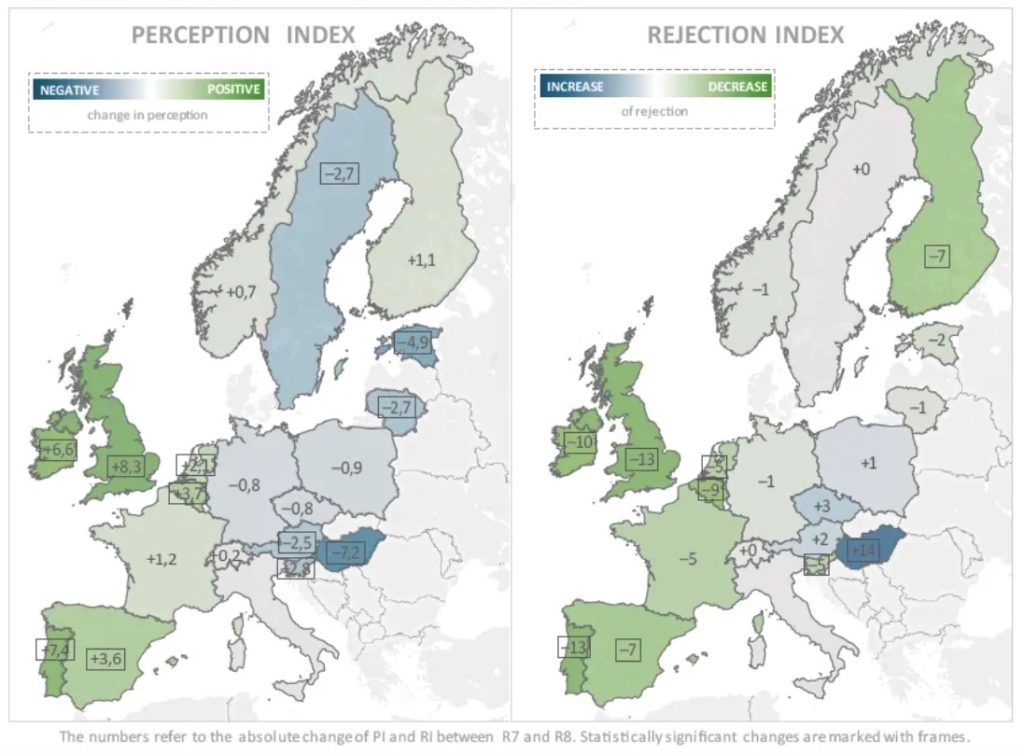
Part of the explanation can be found in the intergroup contact theory. This theory states that “Positive nurtured contact with individuals from a different ethnic or national group leads to a more positive attitude toward that group”[24]. Indeed, the more people engage in positive interactions; the more positive attitudes increase. Comparing the two graphs, Figure 5[25] puts forward the benefits of intergroup contacts. Taking two opposite countries, Sweden and Bulgaria: 52% of Swedish have daily interactions with immigrants compared to 1% of Bulgarians; 85% of Swedish have a positive perception of the impact of immigrants on society, whereas Bulgarians are only 18%. Thus, we can acknowledge the positive effect of interactions on attitudes towards immigrants.
Figure 5
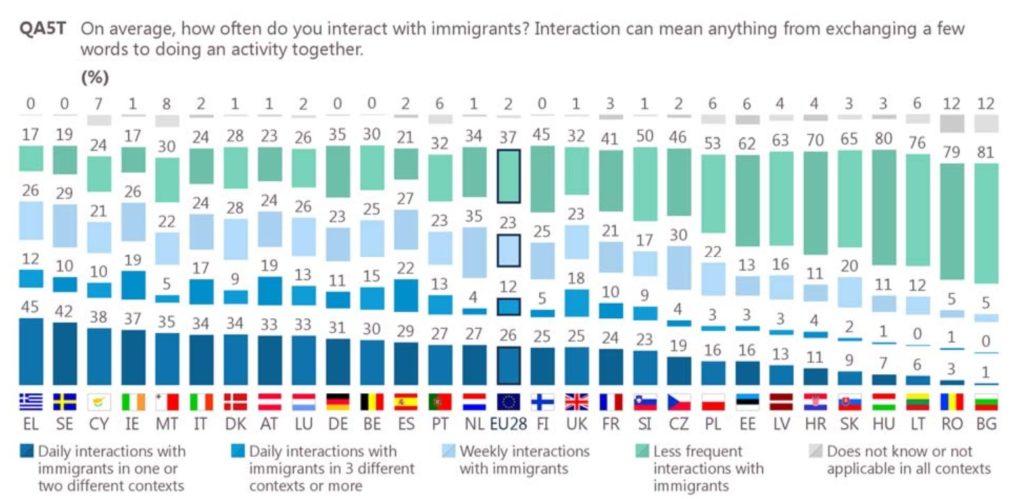
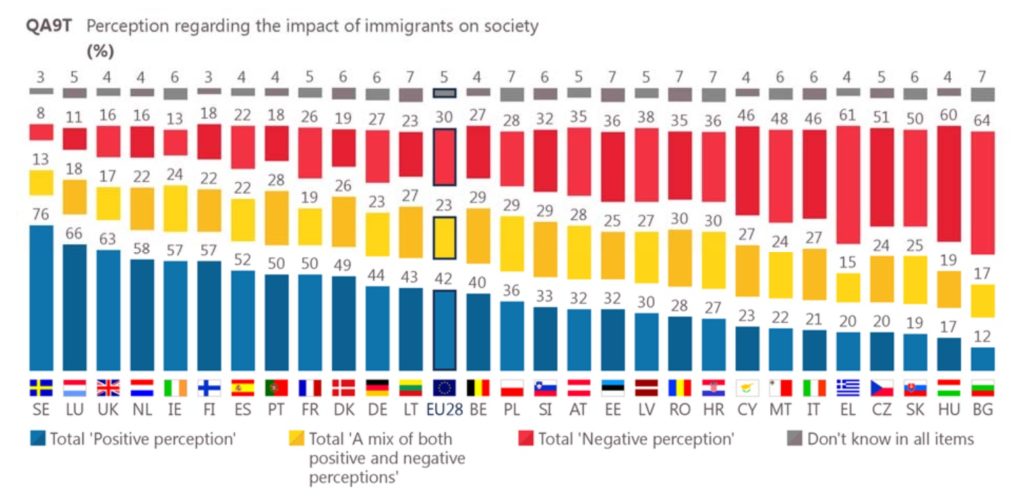
Greece is an interesting case as 57% of Greeks have daily interactions with immigrants, but only 28% of Greeks think that migrants have a positive impact on society. This finding can be explained by the fact that Greece is one of the countries that still needs to manage influx on migrants on its shores. As the camp Moria’s fire, or the Samos riots showed, this situation creates tensions between Greeks and newly arrived migrants. Thus, this example confirms that intergroup contact participates in increasing positive attitudes towards immigrants, only if these contacts are positive too.
Political framing’s impact on anti-immigrant attitudes
Immigration is a highly political issue. Indeed, as the Brexit campaign revealed, attitudes towards immigration in the public opinion can be a determinant for political actors. Conversely, the Brexit campaign also showed that the immigration issue can be instrumentalized by politicians or parties for their own interests. It is the case of right-wing populist parties, that have constructed their rhetoric on immigration. For example, the leader of the right-wing populist Party for Freedom in the Netherlands, Geert Wilders, instrumentalized concerns about the arrival of refugees after the 2015 Paris attacks. He said that “The West was “at war” with Islam”[26], and used that instrumentalization of fear throughout the 2017 Dutch elections. By calling on the “symbolic threat” of Muslim immigration, he tried to attract people’s attention to gain votes. Therefore, these individuals or groups tend to frame the debate and the perceptions of immigration. This is why politicians play a role in defining anti-immigrant attitudes.
Media and misinformation
Media framing: focusing on some aspects of immigration
Media can have a relatively big role in framing the debate about migration, by centering the attention on certain aspects of this issue. Indeed, they are an important source of information, and so people’s exposure to certain media and information can shape their attitudes towards migration. For example, in Italy, “in 2017 media reports about migration were numerous, especially regarding incoming migration flows, which accounted for 44 percent of news; cases of crimes committed by migrants of asylum seekers totaled 16 percent of news”[27]. Adding Figure 6’s results[28], we can see that Italians tend to relate immigrants to the crime problem in their country more than the average Europeans (75% Italians agree, whereas 55% of Europeans agree). Hence, media framing influences the perception of immigrants.
Figure 6
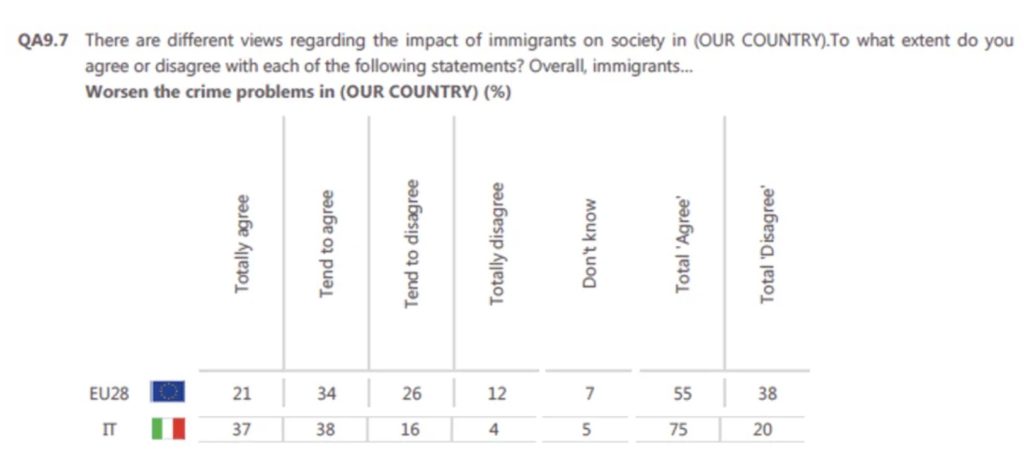
Besides, “press freedom and ownership”[29] is significant in the formation of public attitudes towards immigration. This assumption relates to the one that political framing is important. Indeed, when politicians own media, they can influence the media coverage of immigration. And even if they do not own media, a country’s leaders can affect the media coverage of immigration by limiting press freedom[30]. If these leaders or politicians are anti-immigrant, they can choose to favor negative media coverage of the issue. As put forward by Huddleston and Sharif, “Researchers argue that Hungary’s ruling Fidesz party has taken indirect and direct control of 90% of media outlets (Dragomir, 2017)”[31]. Therefore, the strength of anti-immigrant attitudes in Hungary is influenced by its leader’s party views on this matter. Selective exposure through social media strengthens anti-immigrant attitudes.
Selective exposure through social media strengthens anti-immigrant attitudes
Social media tend to shape even more attitudes towards immigration, since they represent an open space to share opinions, but also where fake news thrive. The social networking platforms, such as Facebook or Twitter, allow a great flow of information that is often partial and not verified. Although these data are fake news, people still notice them, and shape their opinions. On November 17, 2015, Trump tweeted “Refugees from Syria are now pouring into our great country. Who knows who they are – some could be ISIS? Is our president insane?”[32]. Thus, Trump’s use of Twitter is the great example of how fake news can be used by politicians or interest groups[33] to shape public opinion and appeal to their fear. Regarding immigration, which is a controversial and sensitive issue, social media become a useful and powerful tool to appeal to insecurity and fear and boost anti-immigrant sentiments.
Besides, social media, with their algorithms, deepen what psychologists call “motivated reasoning”. It is “ a process by which information is molded to fit (one’s) existing views and the values of the group(s) (one’s) identify with (…) Information contradicting an individual’s sense of self or group identity is often rejected more forcefully than other data, regardless of the evidence backing it up”[34]. Therefore, social media’s algorithms tend to reinforce this behavior, since they lead to a selective media exposure that fits with one’s opinion. In brief, we hear what we want to hear, even if the facts contradict our beliefs. For instance, in general, Europeans tend to overestimate the proportion of immigrants in their country. However, there are disparities between countries. As we can see in Figure 7[35], countries that have a negative stance on immigration (such as the Visegrad group), are the countries where the distortion between facts and reality about the proportion of immigrants is the biggest. Part of the explanation relies on the fact that thinking immigrants are numerous in a country, even if statistics show the contrary, justifies the threat perception, and so anti-immigrant attitudes.
Figure 7
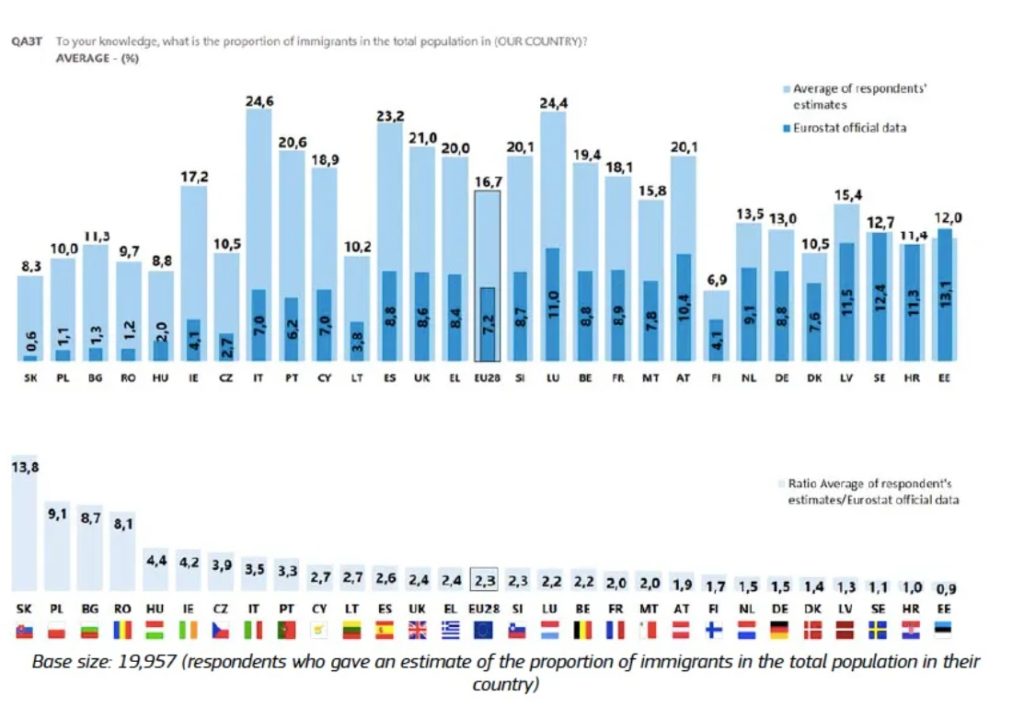
Therefore, the anti-immigrant sentiment is a complex issue with several drivers that need to be interlinked. In this article, drivers of anti-immigrant attitudes are analyzed at the group level. However, the individual level is also important to assess in this issue, since one’s education, age or financial struggles weight in the balance too[36]. Furthermore, in this article, several graphs are used in order to give an overview of European countries’ attitudes towards immigrants. It is important to underline the fact that each survey’s results depend on the way the survey was conducted: the sample, the way questions are asked, the words chosen for the question and the overall context in which the survey is done matter. Nevertheless, it helps understand how anti-immigrant attitudes are shaped, and a better understanding of this sentiment can help policy makers to counter it.
Anne-Lise Tabaud – EU Logos
[1] TNS opinion & political, and European Commission Directorate-General for Migration and Home Affairs, “Special Eurobarometer 469 : Integration of immigrants in the European Union- Report”, European Union, April 2018 (fieldwork in October 2017), p.57
[2] SCHLUETER, Elmar and SCHEEPERS, Peer, “The relationship between outgroup size and anti-outgroup attitudes: A theoretical synthesis and empirical test of group threat-and intergroup contact theory”, Social Science Research, 2010, vol. 39, no 2, p. 286
[3]Ibid
[4] Ibid
[5] VALA, Jorge, PEREIRA, Ccero, and RAMOS, Alice, “Racial prejudice, threat perception and opposition to immigration: A comparative analysis”, Portuguese Journal of Social Science, 2006, vol. 5, no 2, p.120
[6] Portail de la Solidarité Internationale, “ À quoi est dû le sentiment anti-immigration ? », France Terre d’Asile, 15 January 2014
[7] TNS opinion & political, and European Commission Directorate-General for Migration and Home Affairs, “Special Eurobarometer 469 : Integration of immigrants in the European Union- Report”, European Union, April 2018 (fieldwork in October 2017), p.71
[8]This assumption must be nuanced, since the increasing anti-immigrant sentiment related to terrorist attacks depends on several factors, such as the size of the immigration flow, the size of the immigrant group in the country, and also the economic and political contex, LEGEWIE, Joscha, “Terrorist events and attitudes toward immigrants: A natural experiment. American journal of sociology” 2013, vol. 118, no 5, p.7
[9]Ibid, p.29
[10]BANULESCU-BOGDAN, Natalia, « When Facts Don’t Matter: How to Communicate More Effectively about Immigration’s costs and Benefits”, Migration Policy Institute Research Report, November 2018, p.8
[11] LAHAV, Gallya and COURTEMANCHE, Marie, “The ideological effects of framing threat on immigration and civil liberties”, Political Behavior, 2012, vol. 34, no 3, p. 483.
[12] GUIA, Aitana, “The concept of nativism and anti-immigrant sentiments in Europe”, European University Institute – Max Weber Programme, 2016, p.11
[13] Ibid, p.1
[14] Ifop, « Enquête sur le complotisme », Fondation Jean-Jaurès and Conspiracy Watch, Décembre 2017, p.26
[15] Ibid
[16]AFP, « Le « grand remplacement », cette théorie complotiste néonazie qui a inspiré le terroriste de Christchurch », RTBF.be, 15 March 2019
[17]Ifop, « Enquête sur le complotisme », Fondation Jean-Jaurès and Conspiracy Watch, Décembre 2017, p.26
[18] “Racial prejudice is defined in the literature as a collection of negative attitudes ‘‘toward a socially defined group and toward any person perceived to be a member of that group’’ (Ashmore, 1970, p. 253)”, GORODZEISKY, Anastasia and SEMYONOV, Moshe, “Not only competitive threat but also racial prejudice: Sources of anti-immigrant attitudes in European societies”, International Journal of Public Opinion Research, 2016, vol. 28, no 3, p.4
[19] “The percentage of respondents expressing racial prejudice toward all non-Europeans/non-Whites ranges between 5% (in Sweden) and 22% (in Ireland) (…) Czech Republic, U.K., and Hungary (21%, 18%, and 18%, respectively) and (…) the Scandinavian countries (9% in Finland and Norway and 6% in Denmark). The percentage of individuals holding prejudicial views in the other countries falls around the European mean (14.5), ranging from 16% in Belgium, France, and Slovakia to 14% in Bulgaria and Poland, and 13% in Germany and Spain”, Ibid, p.10
[20] WIKE, Richard, STOKES, Bruce and SIMMONS Katie, “European Fear Wave of Refugees Will Mean More Terrorism, Fewer Jobs”, Pew Research Center, 11 July 2016
[21] VALA, Jorge, PEREIRA, Ccero, and RAMOS, Alice, “Racial prejudice, threat perception and opposition to immigration: A comparative analysis”, Portuguese Journal of Social Science, 2006, vol. 5, no 2, p.122
[22] SCHLUETER, Elmar and SCHEEPERS, Peer, “The relationship between outgroup size and anti-outgroup attitudes: A theoretical synthesis and empirical test of group threat-and intergroup contact theory”, Social Science Research, 2010, vol. 39, no 2, p. 285
[23] MESSING, Vera et SÁGVÁRI, Bence, « Still divided, but more open: Mapping European attitudes towards migration before and after the migration crisis”, Friedrich Ebert Stiftung, 2019, vol. 90, p.15
[24] Free Translation of the author, « contact positif nourri avec des individus d’un groupe ethnique ou national différent entraîne une attitude plus positive envers ledit groupe », Portail de la Solidarité Internationale, “ À quoi est dû le sentiment anti-immigration ? », France Terre d’Asile, 15 January 2014
[25] TNS opinion & political, and European Commission Directorate-General for Migration and Home Affairs, “Special Eurobarometer 469 : Integration of immigrants in the European Union- Report”, European Union, April 2018 (fieldwork in October 2017), p.27 & 72
[26] BANULESCU-BOGDAN, Natalia, « When Facts Don’t Matter: How to Communicate More Effectively about Immigration’s costs and Benefits”, Migration Policy Institute Research Report, November 2018, p.8
[27] DEMPSEY, Judy, “Judy Asks: Is Europe Afraid of Migration? ANNALISA CAMILLI- Journalist at Internazionale », Carnegie Europe, 13 September 2018
[28] TNS opinion & political, and European Commission Directorate-General for Migration and Home Affairs, “Special Eurobarometer 469 : Integration of immigrants in the European Union- Report”, European Union, April 2018 (fieldwork in October 2017), p. T30
[29]HUDDLESTON, Thomas, and SHARIF, Hind, “Discussion Brief – Who is reshaping public opinion on the EU’s migration policies?”, RESOMA- Research Social Platform on Migration and Asylum, July 2019, p.17
[30]Ibid
[31] Ibid
[32] https://twitter.com/realdonaldtrump/status/666615398574530560?lang=fr
[33] “A group of people that seeks to influence public policy on the basis of a particular common interest or concern”, Lexico, “Interest group”, Lexico Website, 2020
[34]BANULESCU-BOGDAN, Natalia, « When Facts Don’t Matter: How to Communicate More Effectively about Immigration’s costs and Benefits”, Migration Policy Institute Research Report, November 2018, p.1
[35] TNS opinion & political, and European Commission Directorate-General for Migration and Home Affairs, “Special Eurobarometer 469 : Integration of immigrants in the European Union- Report”, European Union, April 2018 (fieldwork in October 2017), p. 21
